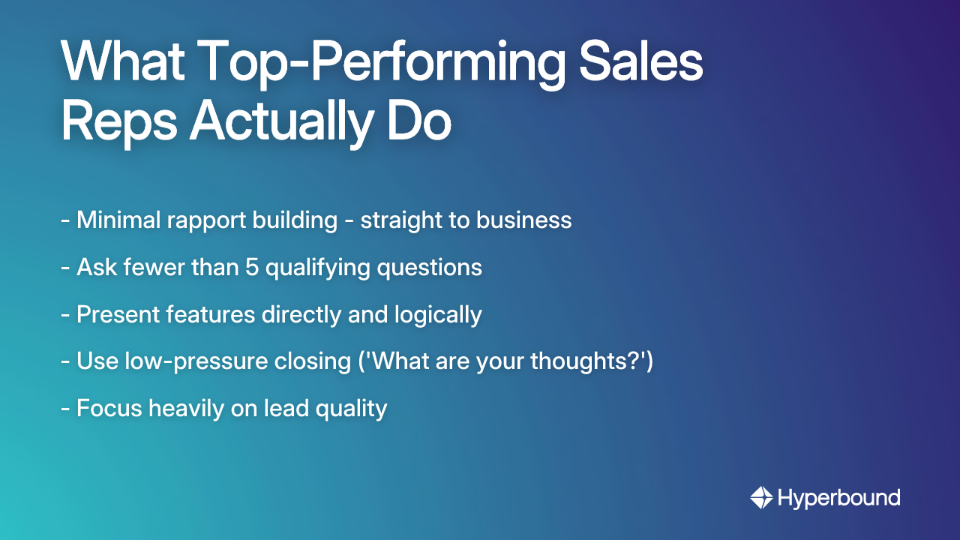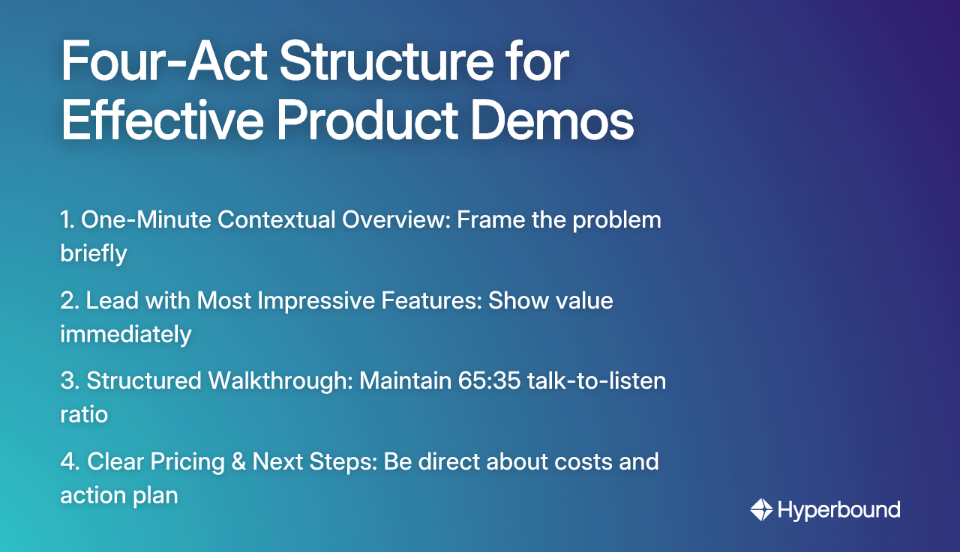
You've sat through dozens of sales training sessions where the mantra is drilled into your head: "Never feature dump. Always sell benefits, not features." You're told to ask probing discovery questions, build rapport, and carefully tailor every demo to each prospect's unique pain points.
But what if that conventional wisdom is wrong?
After analyzing hundreds of B2B SaaS sales calls with conversation intelligence tools, a surprising pattern emerged: "The top sales people are doing, what can only be described as, feature dumping." They build almost zero rapport, ask very few discovery questions, and simply walk through their product's capabilities in a straightforward manner—yet they consistently outperform their peers who follow the traditional playbook.
This isn't about throwing away all sales fundamentals. Rather, it's about understanding when a direct feature presentation is actually what your prospect wants—and when it's the fastest path to closing a deal.
When Top Performers Break the Rules (And Win)
The typical sales playbook reads like a complex choreography: build rapport, ask discovery questions, identify pain points, present tailored benefits, handle objections, and close. Yet when examining actual sales calls from top performers, a different picture emerges:
Minimal Rapport: Top performers have "almost zero rapport. Nothing about personal, nothing about business, just nothing." They respect the prospect's time by getting straight to the point.
Simplified Discovery: Rather than conducting extensive interviews, "the top sales people are asking less than 5 questions in discovery." These aren't complex need-payoff questions but simply "a couple of basic 'are you qualified' questions."
Direct Product Presentation: Instead of crafting personalized benefit statements, they simply show the product's features in a logical sequence. There's no elaborate storytelling—just a clear demonstration of what the product does.
Low-Pressure Closing: The most common closing attempt was simply, "what are your thoughts?" No aggressive techniques or manipulative tactics.
How is this possible? The secret lies not in the technique but in the quality of leads. These deals close easily because "these customers were perfect fits and were in market." When you're showing a well-designed product to a prospect who genuinely needs it, the product sells itself.

The Psychology Behind Effective Feature Presentations
There's a fundamental truth most sales training overlooks: buyers who schedule demos are typically already in the Consideration or Decision stage of their journey. They've recognized their problem, researched potential solutions, and narrowed down their options.
At this point, they don't need to be sold on their pain—they need to see if your product is the right tool for the job. When a salesperson asks, "What happens if you don't solve this problem?" it can feel redundant or even condescending. The prospect knows what happens; that's why they're on the call.
This explains why top B2B SaaS salespeople succeed with direct feature presentations. They understand three key psychological principles:
1. Respect for the Buyer's Journey: Educated buyers don't want to be treated like they're uninformed. They've done their homework and want to see the product, not rehash problems they've already identified.
2. Establishing Authority Through Clarity: A straightforward product walkthrough establishes you as an expert on your solution. Your confidence in showing exactly what your product does—without hiding behind vague benefit statements—builds trust.
3. The Anti-Salesy Effect: Experienced decision makers have developed resistance to traditional sales techniques. When you skip the artificial rapport-building and manipulative questioning, you create a refreshing, honest experience that feels more like collaboration than being sold to.
This doesn't mean feature dumping in a disorganized, rambling manner. There's a structure to an effective product walkthrough that maintains the prospect's attention while demonstrating value.
The Four Acts of a Winning Product Demo
A "good" feature dump isn't chaotic—it follows a clear structure that respects the prospect's time and intelligence:
Act 1: The One-Minute Contextual OverviewBriefly frame the problem your product solves at an industry level. This establishes context without wasting time on the prospect's specific situation, which they already understand.
"Our platform helps B2B SaaS companies streamline their lead qualification process, allowing sales teams to focus on prospects most likely to convert."
Act 2: Lead with Your Most Impressive FeaturesDon't save the best for last. Show your most powerful capabilities upfront to capture attention immediately. This answers their primary question: "Can this solve my problem?"
Act 3: The Structured Walkthrough with InteractionMove methodically through your product's core workflow, maintaining a 65:35 talk-to-listen ratio. This isn't a monologue—pause frequently to ask clarifying questions:
- "Does this workflow align with how your team operates?"
- "Can you see how this might help with the challenges you mentioned?"
These simple questions ensure engagement without veering into manipulative territory. The key is your tone of voice—keep it conversational and genuine, not "salesy." Perfecting this conversational flow is where practice becomes critical, allowing reps to rehearse their demo structure in a safe, simulated environment.
Act 4: Clear Pricing and Next StepsDon't be coy about pricing—address it directly. Research shows that winning demos discuss pricing clearly between the 38-46 minute mark. End by explicitly defining next steps rather than leaving things vague.
"Based on what you've shared, I recommend our Professional plan at $X per user. The next step would be a technical review with your IT team. How does next Tuesday work for that?"

The Strategic Framework: When to Feature Dump vs. When to Personalize
Not all sales situations call for the same approach. The key is matching your demo style to the prospect's context and the complexity of the deal.
Choose a Straightforward Feature Presentation When:
The Lead Quality is High: The prospect fits your ideal customer profile and is actively seeking a solution. They're "in market" and have likely completed significant research already.
The Buyer is Technical or Product-Focused: Engineers, product managers, and hands-on users typically value functionality over high-level benefit stories. They want to see how things work.
The Deal is Transactional: For lower-value, high-velocity sales, an in-depth, personalized demo isn't cost-effective. A standardized, high-impact walkthrough is more efficient for both parties.
Choose a Tailored, Personalized Demo When:
The Deal is a Complex Enterprise Sale: Big ticket sales involve multiple stakeholders, longer sales cycles, and specific security/compliance requirements. Here, personalization is critical to address diverse concerns.
You're Selling to a Buying Committee: When you need to speak to economic buyers, technical evaluators, and end users, a tailored approach helps you address each role's distinct priorities.
The Lead is in an Early Stage: If the prospect is still in the Problem Recognition phase, they need more education and guidance. Personalized demos can help them connect their problems to your solution.
Objection Handling is Complex: Some sales require sophisticated objection handling techniques. Reps must be prepared for any scenario, and building that skill requires consistent practice against realistic objections.

It's Not the Dump, It's the Target
The "feature dump" has been unfairly villainized in sales training. When applied strategically to high-intent, well-qualified leads, it's a powerful, efficient, and respectful way to close deals.
The ultimate lesson from top performers isn't about their demo style, but their relentless focus on lead quality. As one sales leader observed after using AI to analyze hundreds of calls: "The quality of the lead is way more important than anything else."
This explains why "the people relying on marketing were the bottom performers." The best salespeople aren't passively working whatever leads come their way—they're actively pursuing perfect-fit prospects who are already looking for solutions.
Stop forcing every prospect through the same salesy, benefit-driven playbook. Analyze your buyer's readiness and intent. For the educated buyer who knows what they want, dare to give them a clear, confident, and direct look at your product without the sales fluff.
You might find it's the fastest path to "Closed-Won."
Frequently Asked Questions
Why is "feature dumping" often more effective than selling benefits?
A direct feature presentation can be more effective because it respects the time and intelligence of educated buyers who are already in the market for a solution. These prospects have already identified their pain points and want to quickly determine if your product has the specific capabilities to solve their problem, making a straightforward demo the fastest path to a decision.
When should a salesperson use a feature-focused demo?
A feature-focused demo is most effective when the lead quality is high, meaning the prospect fits your ideal customer profile and is actively seeking a solution. It's also ideal for technical or product-focused buyers (like engineers) and for high-velocity, transactional deals where a lengthy, personalized demo isn't efficient.
Are there situations where a personalized, benefit-driven demo is better?
Yes, a tailored, personalized demo is still the best approach for complex enterprise sales with multiple stakeholders and long sales cycles. It is also necessary when selling to a buying committee with diverse needs or when a lead is in the early stages of problem recognition and requires more education to connect their issues to your solution.
How can I structure a feature presentation so it's not just a chaotic list?
An effective feature presentation should follow a clear, four-act structure. Start with a brief contextual overview, lead with your most impressive features to grab attention, conduct a structured walkthrough with interactive questions, and conclude with clear pricing and next steps. This ensures the demo is logical, engaging, and demonstrates value efficiently.
Does this mean I should stop building rapport or asking discovery questions?
No, it means you should adapt your approach based on the lead's quality. For high-intent buyers, top performers minimize rapport-building to get straight to business and ask only a few essential qualifying questions. This respects the prospect's time and avoids redundant questions about pain points they are already aware of.
What is the single most important factor for this sales strategy to succeed?
The most critical factor is the quality of the lead. A direct feature presentation works because you are showing a well-designed product to a prospect who has a genuine, pre-existing need for it. As the analysis shows, top performers succeed with this method because they focus relentlessly on engaging perfect-fit prospects who are already in the market.

Book a demo with Hyperbound
.png)













